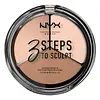NYX Cosmetics 3 Steps to Sculpt, Face Sculpting Palette Versus Makeup by Mario SoftSculpt Transforming Skin Perfector
What's inside
What's inside
 Key Ingredients
Key Ingredients

 Benefits
Benefits

No benefits
 Concerns
Concerns

 Ingredients Side-by-side
Ingredients Side-by-side

Synthetic Fluorphlogopite
Talc
AbrasiveIsopropyl Isostearate
EmollientEthylhexyl Stearate
EmollientDimethicone
EmollientSynthetic Wax
AbrasiveSilica
AbrasiveMagnesium Stearate
Cosmetic ColorantPentaerythrityl Tetraisostearate
EmollientParaffinum Liquidum
EmollientDiisostearyl Malate
EmollientTin Oxide
AbrasiveMethicone
EmollientEthylhexylglycerin
Skin ConditioningPhenoxyethanol
PreservativeTitanium Dioxide
Cosmetic ColorantIron Oxides
Synthetic Fluorphlogopite
Talc
AbrasiveCalcium Aluminum Borosilicate
Dimethicone
EmollientDiisostearyl Malate
EmollientMica
Cosmetic ColorantLauroyl Lysine
Skin ConditioningTrimethylolpropane Triethylhexanoate
EmollientMethyl Methacrylate Crosspolymer
Silica
AbrasiveBis-Behenyl/Isostearyl/Phytosteryl Dimer Dilinoleyl Dimer Dilinoleate
EmollientSorbitan Sesquiisostearate
EmulsifyingSodium Dehydroacetate
PreservativeKaolin
AbrasiveTocopherol
AntioxidantChlorphenesin
AntimicrobialPotassium Hydroxide
BufferingLauryl Acrylate Crosspolymer
Iron Oxides
Synthetic Fluorphlogopite, Talc, Calcium Aluminum Borosilicate, Dimethicone, Diisostearyl Malate, Mica, Lauroyl Lysine, Trimethylolpropane Triethylhexanoate, Methyl Methacrylate Crosspolymer, Silica, Bis-Behenyl/Isostearyl/Phytosteryl Dimer Dilinoleyl Dimer Dilinoleate, Sorbitan Sesquiisostearate, Sodium Dehydroacetate, Kaolin, Tocopherol, Chlorphenesin, Potassium Hydroxide, Lauryl Acrylate Crosspolymer, Iron Oxides
Ingredients Explained
These ingredients are found in both products.
Ingredients higher up in an ingredient list are typically present in a larger amount.
Diisostearyl Malate is an emollient and most often used in lip products. It comes from isostearyl alcohol, a fatty acid, and malic acid, an AHA.
As an emollient, Diisostearyl Malate helps create a thin film on your skin to trap moisture in. This helps keep your skin soft and smooth.
Dimethicone is a type of synthetic silicone created from natural materials such as quartz.
What it does:
Dimethicone comes in different viscosities:
Depending on the viscosity, dimethicone has different properties.
Ingredients lists don't always show which type is used, so we recommend reaching out to the brand if you have questions about the viscosity.
This ingredient is unlikely to cause irritation because it does not get absorbed into skin. However, people with silicone allergies should be careful about using this ingredient.
Note: Dimethicone may contribute to pilling. This is because it is not oil or water soluble, so pilling may occur when layered with products. When mixed with heavy oils in a formula, the outcome is also quite greasy.
Learn more about DimethiconeSilica, also known as silicon dioxide, is a naturally occurring mineral. It is used as a fine, spherical, and porous powder in cosmetics.
Though it has exfoliant properties, the function of silica varies depending on the product.
The unique structure of silica enhances the spreadability and adds smoothness, making it a great texture enhancer.
It is also used as an active carrier, emulsifier, and mattifier due to its ability to absorb excess oil.
In some products, tiny microneedles called spicules are made from silica or hydrolyzed sponge. When you rub them in, they lightly polish away dead skin layers and enhance the penetration of active ingredients.
Learn more about SilicaSynthetic Fluorphlogopite is the synthethic version of mica. It consists of fluorine, aluminum and silicate.
Synthetic Fluorphlogopite is used to add volume to products.
It is considered non-irritating on the skin.
Learn more about Synthetic FluorphlogopiteTalc is a clay mineral. It helps absorb moisture and improve the texture of products. Like other types of clay, Talc can have a slight exfoliating effect on skin. Talc can be added to increase the volume of products.
Some Baby powders are made by combining talc with corn starch. The word "talc" comes from Latin and originates from Arabic. Talc is a mineral commonly found throughout the world.
If you have any concerns about using talc, we recommend checking out the FDA's official page.
Learn more about TalcThis ingredient is a combination of red, black, and yellow iron oxide pigments. This combination of colors is usually found in foundation, because it results in a "skin" color.